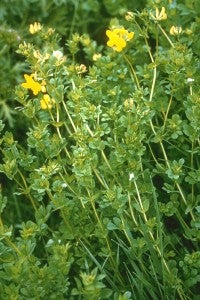Birdsfoot trefoil and condensed tannin forages

Click on the double golden arrows under OREI to see a drop down menu of the posts on this Project including Project Resources. (Located top right of page on computer screen or bottom of page on mobile phone.)
Condensed tannins (CT), also called proanthocyanidins, are naturally occurring plant compounds that significantly affect the nutritional value of forage by forming complexes with proteins, carbohydrates and minerals. Tannins, in low to moderate concentrations, can provide other animal health benefits in addition to observed anti-parasitic effects.
Birdsfoot trefoil (Lotus corniculatus L.) has recently been identified as a promising CT forage well suited to Northeast growing conditions. It is a legume that minimizes bloat, improves protein uptake and has other environmental benefits in addition to possible anti-parasitic effects. Other promising CT legume forages include Sanfoin (more suited to western U.S.) and Sericea lespedeza (does not over-winter well in colder climates).
Research and knowledge are needed to fully explore CT forages and identify the types and amount of bioactive compounds responsible for the gastrointestinal nematode suppression and their modes of action. Best management practices to establish and manage birdsfoot trefoil under organic production standards for pasture and hay production are also required.
2019 Update – Learn more about our new USDA NIFA Organic Transitions Program project entitled, Overcoming barriers to transitioning small ruminants to organic production: Effects of feeding birdsfoot trefoil on parasite control, nutritional status & profitability, that builds from this Sept. 2012 – Aug. 2017 project.
This material is based upon work supported by the National Institute of Food and Agriculture, U.S. Department of Agriculture, Organic Agriculture Research and Extension Initiative under Agreement No. 2012-51300-03654.

 Home
Home Browse
Browse Close
Close Events
Events Maps
Maps Email
Email Brightspace
Brightspace eCampus
eCampus


